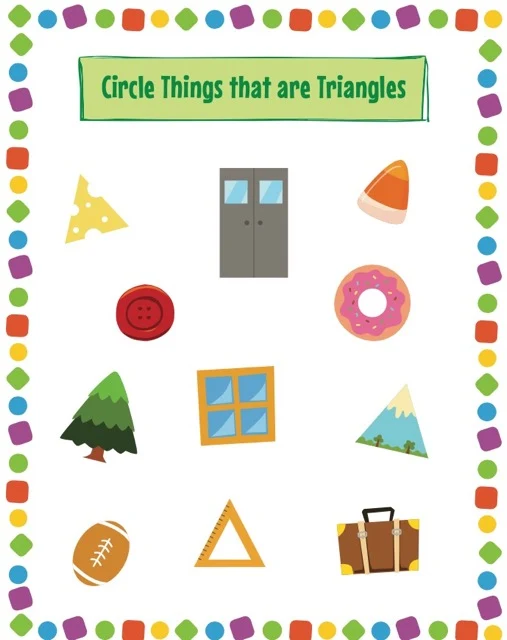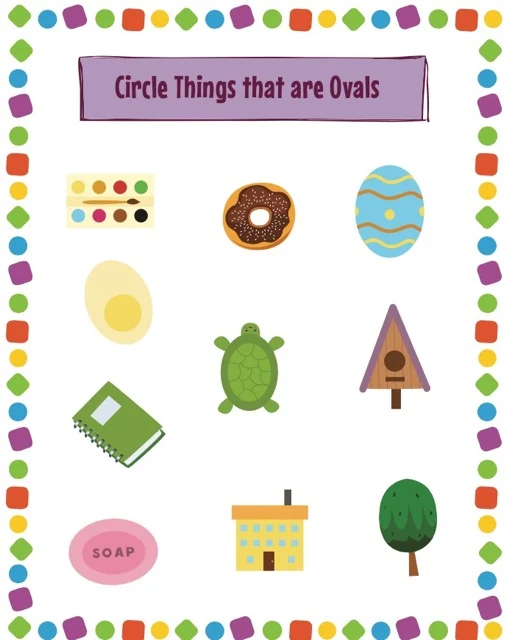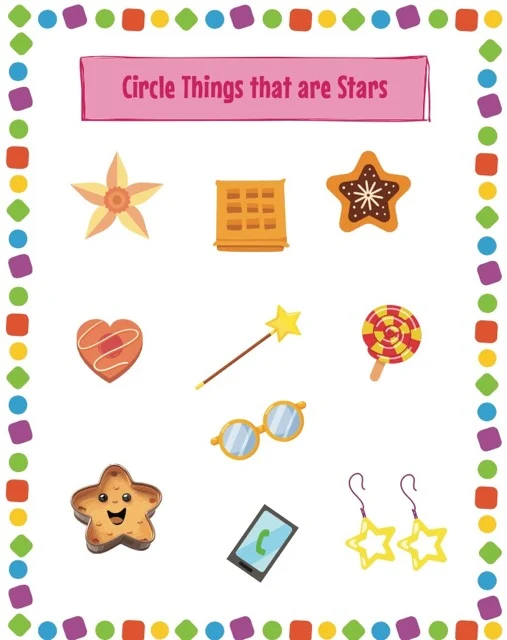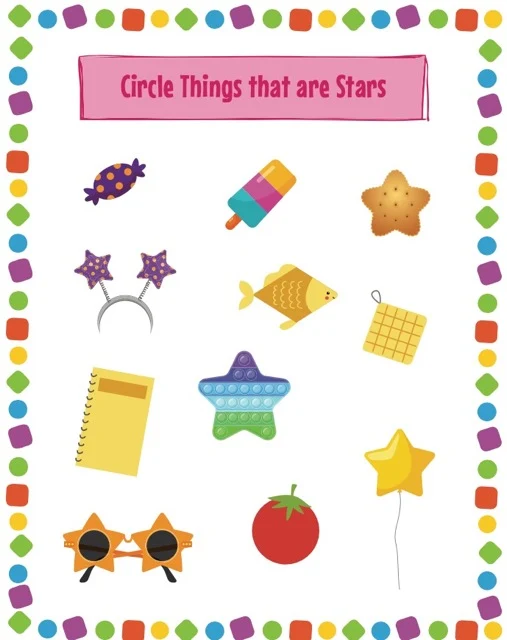Circle the Shape Activities: A Comprehensive Guide
This briefing document summarizes resources on "Circle the Shape" activities, which enhance shape recognition skills. The materials include an FAQ, a study guide offering quizzes and essay questions on the cognitive and pedagogical aspects of shape recognition, and a sample worksheet. The key themes are shape recognition, specifically circle identification, activity adaptation for different skill levels, and alternative activities beyond worksheets. The document emphasizes the benefits of shape recognition for geometry, visual perception, and cognitive development, offering strategies for successful completion of the activity. Finally, the document concludes by highlighting the value of "Circle the Shape" activities in fostering these crucial skills.
Circle Shape Recognition: A Comprehensive Guide
Briefing Document: Circle Shape Recognition
Purpose: This document reviews the main themes and important ideas related to "Circle the Shape" activities, a common tool for evaluating and developing shape recognition skills.
Sources:
1.
"Circle Shape Recognition" FAQ: This source provides an overview of the activity, its purpose, target audience, and benefits.
2.
"Circle the Shape: A Study Guide": This source delves deeper, offering a glossary, short-answer quizzes, and essay questions that explore the cognitive aspects and pedagogical implications of shape recognition.
3.
"Testing Theme: Circle The Shape.pdf": This source provides a visual example of a "Circle the Shape" worksheet.
Main Themes:
●
Shape Recognition: The fundamental ability to identify and distinguish various shapes based on their visual properties. This is crucial for understanding geometry, enhancing visual perception, and fostering cognitive development.
●
Circle Identification: The specific skill of accurately identifying circles amongst other shapes. This requires understanding the defining characteristics of a circle: a perfectly round shape with no corners or edges.
●
Activity Adaptation: The "Circle the Shape" activity can be tailored to suit different skill levels by manipulating the number, complexity, and similarity of shapes included. This allows for progressive learning and individualized challenge.
●
Beyond Worksheets: While worksheets are common, shape recognition can be practiced through various engaging activities like object sorting, block building, shape-themed games, and artistic creation.
Key Ideas/Facts:
●
Purpose of "Circle the Shape": To practice and improve circle identification skills by visually scanning and circling all circles within a set of diverse shapes.
●
Benefits of Shape Recognition:
○
Foundation for geometry: "[Understanding shapes] is crucial for learning more complex geometrical concepts." (Source 1)
○
Improved visual perception: "[Recognizing shapes] helps individuals become more aware of their surroundings and enhances their ability to process visual information." (Source 1)
○
Cognitive development: "[Shape recognition] activities stimulate critical thinking, problem-solving, and attention to detail." (Source 1)
●
Strategies for Success:
○
Careful observation: Take time to analyze each shape.
○
Focus on key characteristics: Look for roundness and absence of corners/edges.
○
Systematic scanning: Use a pattern to avoid missing circles.
○
Double-checking: Review your work for accuracy.
●
Adaptation for Skill Levels:
○
Varying shape quantity: Fewer shapes for beginners.
○
Adjusting shape complexity: Simple shapes for younger learners, more complex shapes for advanced learners.
○
Introducing distractor shapes: Similar shapes like ovals to increase difficulty.
●
Alternative Activities:
○
Object sorting by shape
○
Building with blocks
○
Playing shape-themed games
○
Creating art involving shapes
Analysis of "Testing Theme: Circle The Shape.pdf":
The provided worksheet exemplifies how "Circle the Shape" activities function. It presents a large collection of varied shapes, challenging the individual to locate and circle all the circles. The sheer number of shapes and their diverse arrangements demand focused attention, systematic scanning, and accurate discrimination between circles and other shapes.
Conclusion:
"Circle the Shape" activities are valuable tools for developing shape recognition skills, a foundational element in geometry and visual perception. By understanding the activity's purpose, incorporating effective strategies, and exploring alternative methods, individuals can enhance their ability to identify circles and strengthen their overall cognitive abilities.
Circle Shape Recognition
Circle Shape Recognition FAQ
1. What is the purpose of the "Circle the Shape" activity?
This activity is designed to help individuals practice and improve their ability to identify and differentiate circles from other shapes. It involves visually scanning a collection of various shapes and specifically circling all the circles present.
2. Who can benefit from this activity?
This activity can benefit people of all ages who are working on shape recognition skills. This includes young children learning about basic shapes, students studying geometry, and even adults who want to sharpen their visual perception skills.
3. What types of shapes are included in the activity besides circles?
The activity includes a wide variety of shapes to challenge participants in accurately identifying circles. Some common shapes you might encounter include squares, triangles, rectangles, stars, hearts, ovals, and diamonds.
4. How is the activity structured?
The "Circle the Shape" activity is typically presented as a worksheet or series of pages. Each page features a collection of different shapes arranged randomly. The task is to carefully examine all the shapes and circle every single circle you can find.
5. What are some tips for successfully completing the activity?
●
Take your time: Carefully examine each shape before deciding if it's a circle.
●
Look for key characteristics: Circles are perfectly round with no corners or edges.
●
Use a strategy: You can scan the page systematically, like moving row by row, to ensure you don't miss any circles.
●
Double-check your work: Once you believe you've circled all the circles, go back and review to make sure you haven't missed any.
6. What are the benefits of practicing shape recognition?
Developing strong shape recognition skills has several benefits:
●
Foundation for geometry: Understanding shapes is crucial for learning more complex geometrical concepts.
●
Improved visual perception: Recognizing shapes helps individuals become more aware of their surroundings and enhances their ability to process visual information.
●
Cognitive development: Shape recognition activities stimulate critical thinking, problem-solving, and attention to detail.
7. Can this activity be adapted for different skill levels?
Yes, the difficulty of the activity can be adjusted by:
●
Varying the number of shapes: Fewer shapes can make the task easier for beginners.
●
Changing the complexity of shapes: Using simple, regular shapes is suitable for younger children, while introducing more complex or irregular shapes can challenge older individuals.
●
Adding distractions: Including similar shapes like ovals can make the activity more challenging by requiring closer observation.
8. Are there other ways to practice shape recognition besides worksheets?
Absolutely! Shape recognition can be incorporated into various activities, such as:
●
Sorting objects: Gather everyday objects of different shapes and ask participants to sort them based on their shape.
●
Building with blocks: Use building blocks to create different shapes and discuss their properties.
●
Playing shape-themed games: Many board games and online games focus on shape identification and matching.
●
Creating art: Encourage drawing, painting, or crafting activities that involve creating and manipulating different shapes.
Circle the Shape: A Study Guide
Circle the Shape: A Study Guide
Key Terms Glossary
●
Shape Recognition: The ability to identify and differentiate various shapes based on their visual characteristics.
●
Geometry: The branch of mathematics concerned with shapes, sizes, relative positions of figures, and the properties of space.
●
Visual Perception: The ability to interpret and make sense of visual information from the world around us.
●
Cognitive Development: The development of mental processes such as thinking, reasoning, problem-solving, and memory.
●
Distractor Shapes: Shapes similar to the target shape (in this case, a circle) that serve to make identification more challenging.
Short-Answer Quiz
Instructions: Please answer the following questions in 2-3 sentences.
1.
What is the main purpose of the "Circle the Shape" activity?
2.
Besides circles, what other types of shapes might you find in a "Circle the Shape" activity?
3.
How might you adapt the "Circle the Shape" activity to make it more challenging?
4.
Describe two benefits of developing strong shape recognition skills.
5.
List three real-world activities or games, besides worksheets, that can help someone practice shape recognition.
6.
What are some key characteristics that define a circle as a shape?
7.
How can the "Circle the Shape" activity be modified for different age groups or skill levels?
8.
What strategies can help someone successfully complete a "Circle the Shape" worksheet?
9.
Explain how the provided "Circle the Shape" document could be used as a testing tool.
10.
What might be the purpose of including shapes that are similar to circles, like ovals, in the activity?
Short-Answer Quiz Answer Key
1.
The main purpose of the "Circle the Shape" activity is to help individuals practice and improve their ability to recognize and identify circles. It involves visually scanning a set of various shapes and circling all the circles present.
2.
A "Circle the Shape" activity might include shapes such as squares, triangles, rectangles, stars, hearts, ovals, and diamonds. These different shapes challenge participants to accurately differentiate circles from other shapes.
3.
To increase the challenge of "Circle the Shape," you could increase the number of shapes on the page, introduce more complex or irregular shapes, or include shapes similar to circles (like ovals) to act as distractors.
4.
Two benefits of strong shape recognition skills are a foundation for learning more complex geometrical concepts and improved visual perception. Shape recognition enhances the ability to process visual information and become more aware of one's surroundings.
5.
Real-world activities that can help with shape recognition include sorting everyday objects by shape, building with blocks, and playing shape-themed board games.
6.
A circle is a two-dimensional shape that is perfectly round, meaning all points on the circle's outline are the same distance from its center. It has no corners or edges.
7.
"Circle the Shape" can be adapted for different skill levels by adjusting the number of shapes (fewer shapes for beginners), complexity of shapes (simple shapes for younger children), and by adding distractor shapes (like ovals) to increase difficulty.
8.
Strategies for success include taking time to examine each shape carefully, looking for the key characteristics of a circle (round, no corners or edges), and scanning the page systematically (e.g., row by row) to avoid missing any circles. It's also helpful to double-check your work.
9.
The provided "Circle the Shape" document could be used as a testing tool to evaluate an individual's ability to accurately and efficiently identify circles within a group of various shapes. This can help assess their shape recognition skills and visual perception abilities.
10.
Including shapes similar to circles, like ovals, increases the challenge of the activity by requiring closer observation and discrimination. This helps develop finer shape recognition skills and prevents reliance on simple visual cues.
Essay Questions
1.
Discuss the importance of shape recognition as a foundational skill for learning geometry and other STEM-related concepts. How does understanding shapes contribute to a deeper understanding of mathematical principles?
2.
Explain how shape recognition activities can benefit individuals beyond their academic development. How can these activities impact their daily lives and interactions with the world around them?
3.
Evaluate the effectiveness of using worksheets as a tool for teaching and practicing shape recognition. What are the advantages and limitations of this approach? Discuss alternative methods for developing shape recognition skills in a more engaging and interactive manner.
4.
Analyze the cognitive processes involved in shape recognition. How does the brain process visual information to identify and categorize different shapes? Explore the role of perception, memory, and attention in shape recognition.
5.
Design a comprehensive lesson plan for teaching shape recognition to a specific age group (e.g., preschoolers, elementary school students, or adults). Include a variety of activities, materials, and assessment strategies that cater to the learners' developmental level and learning styles.







































